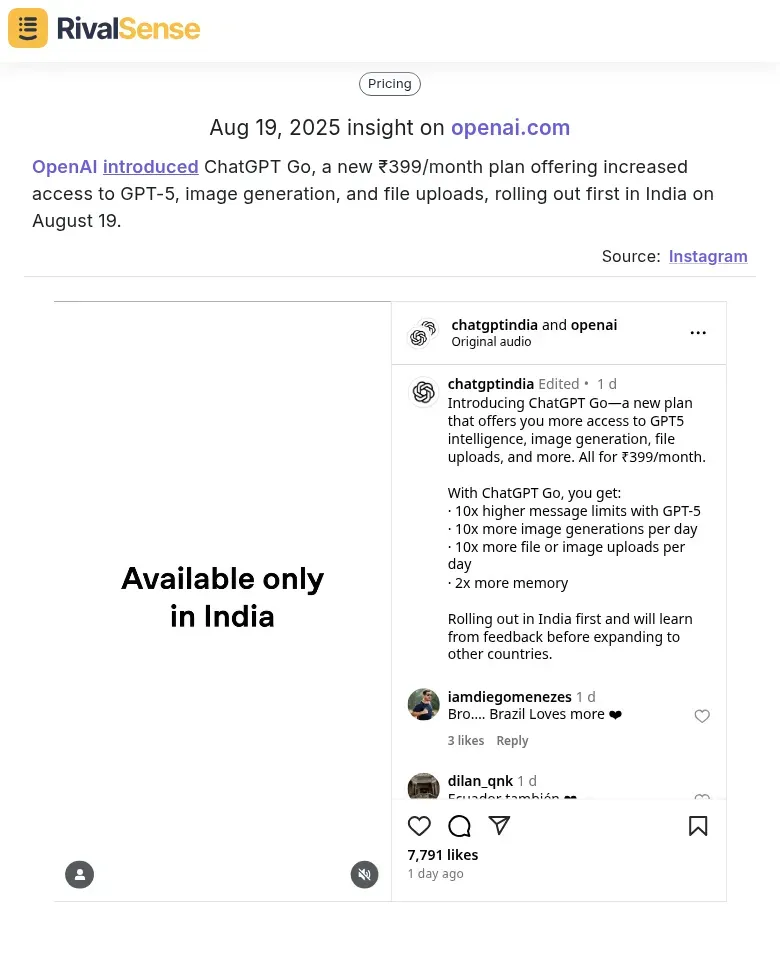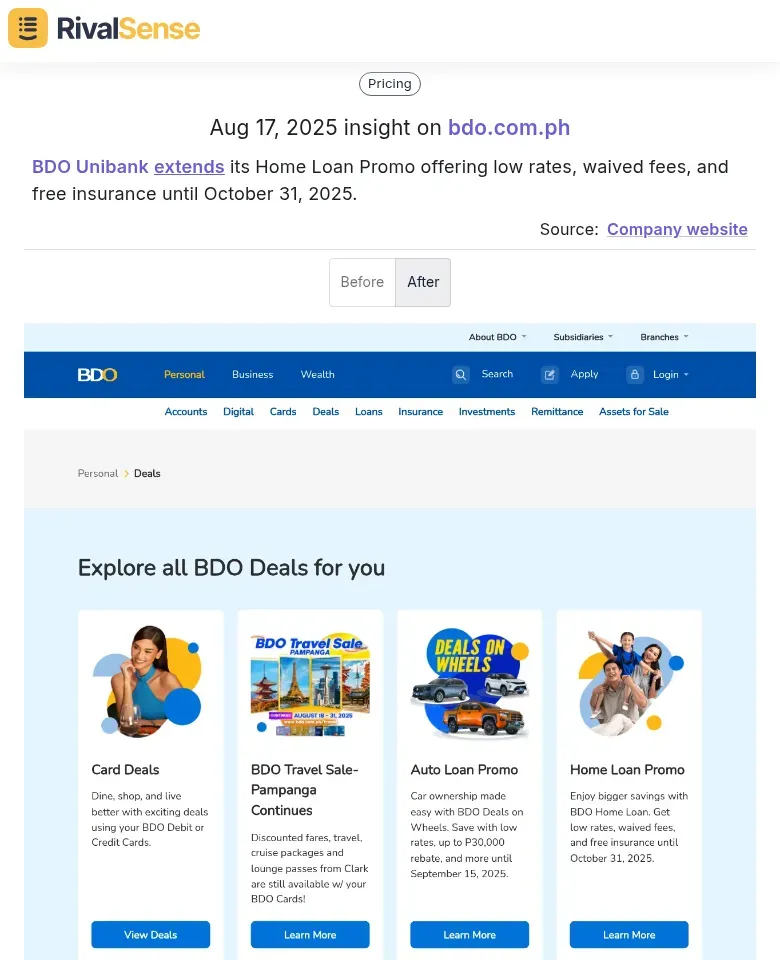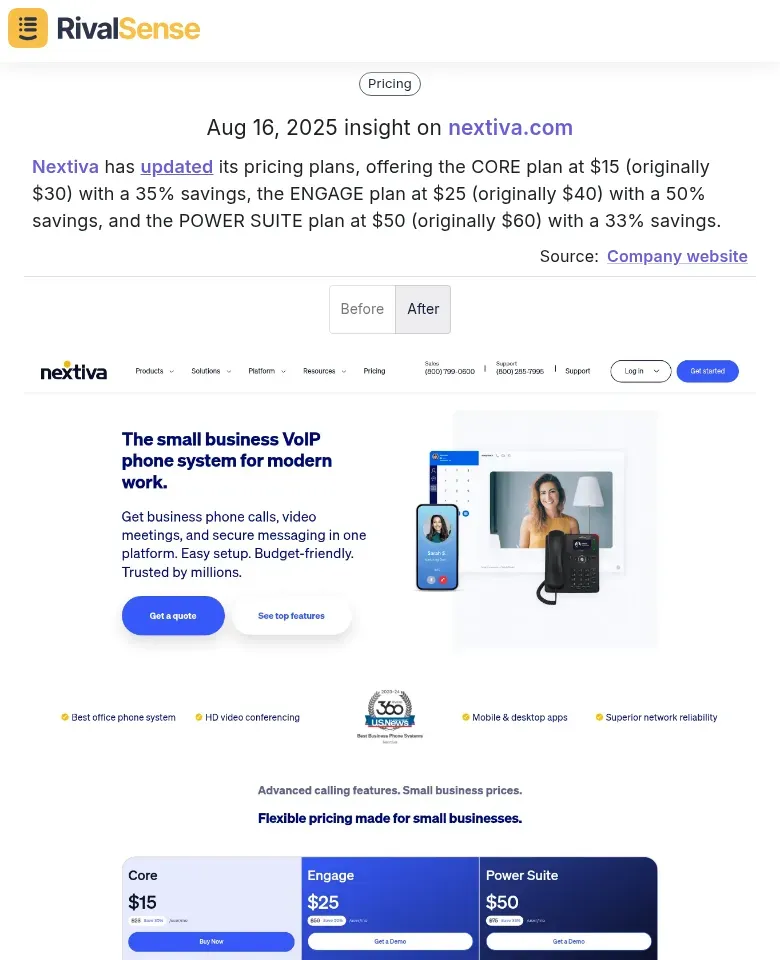Leverage Competitor Pricing Insights for Strategic Partnership Termination
When partnerships dissolve, competitor pricing insights become your strategic compass for navigating the transition. Understanding how rivals price similar offerings provides critical context for your own pricing decisions during this vulnerable period. Competitive intelligence helps you mitigate risks like customer defection by revealing market-rate alternatives, while identifying opportunities to capture market share through strategic pricing adjustments.
For example, OpenAI introduced ChatGPT Go, a new ₹399/month plan offering increased access to GPT-5, image generation, and file uploads, rolling out first in India on August 19. This type of regional pricing insight is invaluable for understanding market-specific adaptations and competitive positioning during partnership transitions.

Practical tip: Create a competitor pricing dashboard that tracks 3-5 key rivals, monitoring their pricing changes weekly during the termination process. This real-time data enables you to maintain competitive positioning, avoid pricing yourself out of the market, and potentially attract customers seeking stability amid the partnership change. Remember to cross-reference pricing data with customer feedback to validate your strategy's effectiveness.
Analyzing Competitor Pricing Strategies: Key Patterns and Trends
Analyzing competitor pricing strategies reveals critical patterns that inform partnership decisions. Start by mapping regional variations—many SaaS companies offer India-specific plans at 40-60% lower prices than US equivalents, reflecting purchasing power parity. Track these through competitor websites and tools like RivalSense to identify market-specific adaptations.
Seasonal timing patterns are equally revealing. Monitor competitors for Q4 holiday discounts (typically 20-30% off), back-to-school promotions in August, and mid-year sales around June. Create a calendar of these events to anticipate market movements and avoid price wars during peak discount periods.
Tiered pricing analysis shows how competitors differentiate value. Examine feature gating across plans: entry tiers often limit integrations or support, while premium plans include white-label options and dedicated account management. Note how competitors justify price increases with tangible value additions rather than arbitrary segmentation.
✅ Practical steps:
- Use VPNs to view competitor pricing in different regions
- Set up alerts for price changes and promotional announcements
- Document feature comparisons across pricing tiers quarterly
- Calculate value-per-feature ratios to benchmark against your offerings
- Test regional pricing in one market before full rollout
Leveraging Pricing Intelligence for Contract Transition Planning
When navigating partnership terminations, leverage competitor pricing intelligence to craft compelling transition offers that retain value. Start by analyzing competitors' pricing structures during similar market cycles—track promotional periods, discount strategies, and seasonal fluctuations.
For instance, BDO Unibank extends its Home Loan Promo offering low rates, waived fees, and free insurance until October 31, 2025. Such limited-time promotional insights help you time your transition offers effectively and understand how competitors use temporary incentives to capture market attention.

Use this data to time your pricing adjustments, aligning with competitor promotional windows to maximize appeal. For example, if a key competitor launches a Q4 discount campaign, introduce your transition offer concurrently to capture attention.
Develop value-based pricing strategies that emphasize unique differentiators, such as superior customer support or exclusive features, rather than competing solely on price.
📋 Create a transition planning checklist:
- Monitor competitor pricing trends weekly
- Identify optimal timing based on market opportunities
- Calculate competitive offer thresholds using benchmark data
- Highlight value propositions in communications
This approach ensures a smooth transition while maintaining competitive edge.
Ethical Considerations and Best Practices in Competitive Pricing Intelligence
When gathering competitor pricing intelligence during partnership transitions, maintaining ethical boundaries is paramount. Stick to publicly available information only—competitor websites, press releases, financial reports, and social media are fair game. Avoid deceptive tactics like posing as customers or accessing restricted data, which violate trust and legal standards.
To prevent price wars and predatory practices, ensure your pricing strategy doesn't involve below-cost pricing aimed at eliminating competition, as this breaches antitrust regulations like the Sherman Act. Focus on value-based pricing instead, aligning with market rates without undercutting to harm rivals.
✅ Best practices checklist:
- Use competitive intelligence tools that automate monitoring of public data
- Train teams on ethical guidelines (e.g., SCIP's Code of Ethics)
- Avoid hiring competitors' employees to gain insider information
- Consult legal counsel on antitrust compliance regularly
- Document all intelligence sources to demonstrate transparency
Balancing intelligence with fair practices not only avoids legal risks but builds long-term credibility and trust in the market.
Implementing Data-Driven Pricing Strategies Post-Termination
After terminating a partnership, implementing data-driven pricing strategies is crucial for maintaining competitiveness. Start by developing dynamic pricing models that leverage real-time competitor intelligence.
Nextiva has updated its pricing plans, offering the CORE plan at $15 (originally $30) with a 35% savings, the ENGAGE plan at $25 (originally $40) with a 50% savings, and the POWER SUITE plan at $50 (originally $60) with a 33% savings. This type of comprehensive pricing restructuring insight is critical for understanding how competitors reposition their offerings and create value-based pricing structures.

Use tools to track competitor prices, demand signals, and market trends automatically. Set up rule-based pricing (e.g., maintain a 5% discount to key rivals) or AI-driven models that adjust prices based on real-time data feeds.
Create flexible pricing structures that can adapt quickly. Implement tiered pricing for different customer segments (e.g., enterprise vs. SMB) and build in elasticity for volume discounts or seasonal adjustments. Use A/B testing to validate new price points before full rollout.
Measure effectiveness through continuous competitor monitoring. Track KPIs like price realization rates, margin changes, and win/loss ratios against competitors. Set up automated alerts for competitor price changes. Conduct quarterly pricing audits to ensure alignment with market conditions and adjust strategies based on performance data.
📋 Practical implementation checklist:
- Integrate pricing tools with CRM/ERP systems
- Establish baseline metrics pre-implementation
- Train sales teams on new pricing logic
- Monitor competitor moves daily
- Review pricing performance weekly
Conclusion: Building a Sustainable Competitive Advantage Through Pricing Intelligence
Integrating competitor pricing insights into your long-term strategy transforms reactive responses into proactive market leadership. Beyond partnership terminations, establish continuous competitive intelligence processes by implementing automated price monitoring tools that track key competitors daily. Set up monthly pricing review meetings where cross-functional teams analyze trends and adjust strategies accordingly.
🚀 Practical steps for sustainable advantage:
- Create a pricing intelligence dashboard with real-time competitor data
- Develop quarterly competitive pricing reports shared with leadership
- Implement A/B testing for pricing strategies based on competitor movements
- Build scenario plans for different market conditions and competitor actions
Leverage pricing data to build resilient business models by identifying pricing gaps and opportunities before market shifts occur. Use this intelligence to inform product development, marketing positioning, and customer segmentation strategies. The most successful companies treat pricing intelligence not as a defensive tactic but as an offensive weapon for market domination.
Ready to gain these competitive insights for your business? Try out RivalSense for free to get your first competitor report today and stay ahead of market changes with weekly intelligence delivered straight to your inbox.
📚 Read more
👉 OpenAI's New Developer Portal: What It Means for Your Competitive Strategy
👉 Business Partnership Value Creation: A Practical Guide with Actionable Steps
👉 Water Treatment Partnership ROI: Financial Analysis Case Study for Strategic Decision-Making
👉 Predictive Facebook Competitor Insights for Partnership ROI: From Reactive to Proactive Strategy
